History of syringes and needles
In medical literature, the origin of the syringe can be traced back to the early years of the AD. Since then, syringes can be made of all kinds of materials from metal, glass, even gold and recently silicon.
How did syringes and needles come about?
Syringes were invented long before hypodermic needles. Their origins can be traced back to Greek and Roman history, where they were used in ritual anointings or when the ancients used pistons to change the pitch of certain musical instruments.
Syringes with simple pistons for applying creams and ointments were described in medical literature by Gallen (129-200 AD).

The syringe was invented long before the hypodermic needle.
In 1650, Pascal's experiments with hydraulics inspired Christopher Wren to invent the first modern syringe for administering medicine. He used the technique of abstinence to inject poppy sap into a dog's veins through a syringe made of goose feathers.
By 1660, physicians Major and Esholtz were using similar methods to inject humans, but with fatal consequences due to failure to calculate the correct dosage and to sterilize the instruments. This incident delayed the use of injections for another 200 years.
The first hypodermic needle was invented by Francis Rynd in 1844 in Dublin, Ireland, and was made of steel.
A syringe usually consists of three parts: the body of the syringe (made of glass, plastic or metal), the cylinder and the piston which can be made of rubber, metal or synthetic material. In the early days of syringes, people also had to use tape to prevent water from leaking out of the syringe.
Charles Pravaz in France injected a blood coagulant into sheep in 1853. Alexander Wood in Edinburgh, England combined the syringe with the hypodermic needle that same year to inject morphine into humans.
The basic design of the syringe has not changed since then. The use of plastic led to the introduction of disposable syringes, which have been popular since the mid-1950s.
Silicon micro-needle, so small it's painless - the potential of the future
Nowadays, the use of drugs and vaccines through injections is very common, and science has even advanced to the point where it is possible to deliver drugs directly through the skin. Scientists are developing needles made from silicon microspheres, so small that they are painless because they cannot activate the nerves that cause pain.
However, the limitation of silicon micro needles is that they cannot be used for intravenous injection or rapid injection.
Shapes of different types of specialized needles
For each type of disease or to serve a specific purpose, the needles will be designed differently. In the past, needles were even made of gold to ensure sterility. Needles for spinal punctures or needles for hemorrhoids are different from ordinary needles.

Figure 1 - Three generations of syringes.
Figure 1 shows three generations of syringes. At top left is a disposable syringe from the 1950s, of varying lengths and sizes. At top right is a widely used miniature needle with a color-coded plastic shaft. At bottom is a screw-on, double-ended needle from the 1930s, used to refill pens.
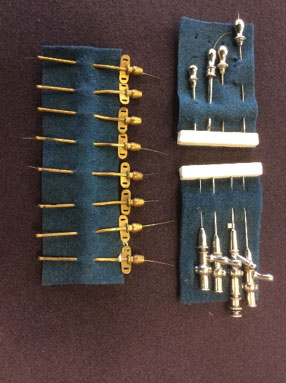
Figure 2. Sterile gold syringe, early 20th century.
In Figure 2, the needle with the bulbous shaft is attached directly to the rubber. The needle is used to withdraw air from the pleural cavity to treat pneumothorax.
Hamilton Bailey type IV needles, 8 needles from the early 20th century, made of gold for sterility, with slots for inserting support bandages.

Figure 3. Aspiration needle with a pointed tip for easy insertion through the skin.

Figure 4. Gord infusion needle.
In Figure 4, the Gord infusion needle is equipped with a removable rubber membrane for easier intravenous administration. This type of needle was used for many years until the introduction of the single-use "butterfly needle" in 1960.
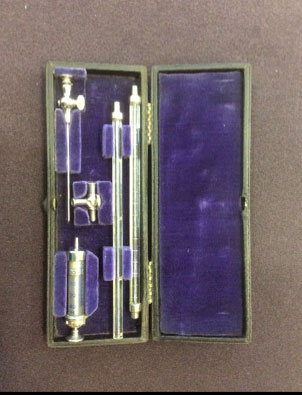
Figure 5. Needle for measuring pressure and examining spinal fluid.
In Figure 5 is a set of needles used in the 1930s to measure pressure and test spinal fluid.

Figure 6. Syringe used for hemorrhoids.
In Figure 6, the needle used for hemorrhoid patients is designed to prevent deep penetration during injection. The safety needle lock ensures the necessary pressure is applied without the needle falling off.
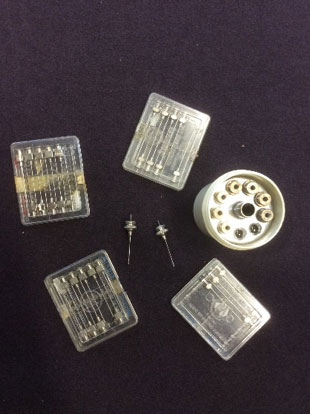
Figure 7. Common syringes and syringe containers from 1920-1950.
In Figure 7, common syringe needles from the 1920s to the 1950s often became blunt from repeated use. Inadequate cleaning and sterilization led to infections in some cases, leading to cellulitis and abscesses. Back then, needle sharpeners were even used, as in Figure 8.
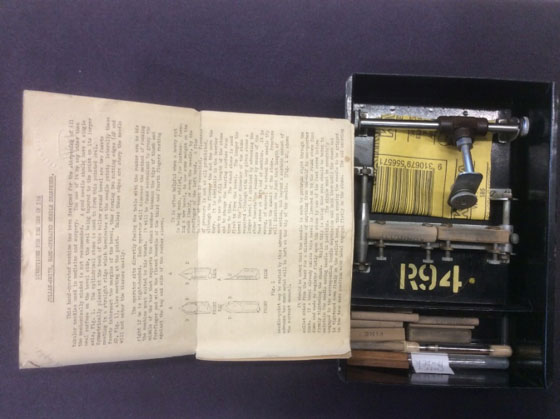
Figure 8. Needle grinding equipment.
Various specialized syringes and injection kit containers

Figure 9. Pocket syringe set.
In Figure 9, a pocket syringe set patented around 1910, containing a standard quantity of a dissolved preparation for injection after reconstitution in distilled water.
Only later did pharmaceutical manufacturers prepare sterile injections in sealed glass tubes.

Figure 10. Anesthetic syringe set.
In Figure 10, the anesthetic syringe set is widely used by general practitioners and specialists.

Figure 11. Antique syringe circa 1875.

Figure 12 - Figure 13 - Figure 14.
There are many types of syringes made from glass to metal, but the Rekordsprize syringe introduced by the Berlin manufacturers Dewitt and Hertz in 1906 (Figure 12) stands out for its reliability, leak-free, jam-free, and easy disassembly for sterilization.
This model existed until the advent of plastic syringes.
This design has been produced by many companies around the world with minor variations. In Figure 13, the glass syringe is preferred but is more prone to jamming and leaking. In Figure 14, the cartridge syringe is popular with dentists and is often a staple in first aid kits.

Figure 15.
In Figure 15, the catheter has a copper sheath and a thick metal syringe with a sturdy screw lock that retains heat so that molten paraffin wax can be injected to make a specimen for pathology classes.
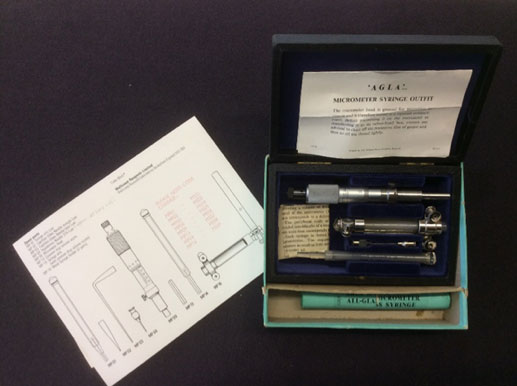
Figure 16.
An unusual syringe is the AGLA Micrometer Syringe Set shown in Figure 16. This syringe is designed for the analysis of dilute concentrations of biological solution components where precise concentration measurements are required. The accompanying instructions indicate that this syringe set is specifically used in immunological research and evaluation where serial dilutions are important.
Needles and syringes are routinely sterilized in sets, by simple boiling but in clinics and hospitals autoclaves are used to achieve higher temperatures. Syringe sets allow non-replaceable parts to be kept together.
Single-use products currently predominate although glass may sometimes be preferred over plastic due to the properties of the substance being injected.
However, most syringes, IV sets, and IV catheters are made of plastic with stainless steel needles, wrapped in cellophane, and sterilized by gamma irradiation (Figure 17).
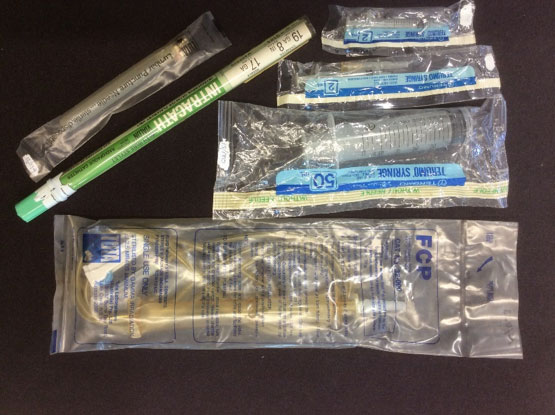
Figure 17. Disposable syringe.

Figure 18. Modern, expensive injectable drugs are usually administered using single-dose syringes, which have plastic and rubber plungers with sealed needles attached to glass tubes for self-injection by the patient.
- Self-destruct syringes
- Everyone should use smart syringes by 2020
- Automatic syringes
- Painless needles by porcupine
- US micro-robotic systems carry syringes into the spinal cord
- Syringe painless laser
- Nurses often snap on needles before injection, do you know why?
- Micro needles take drugs to every corner of the brain
- Ultra small needles dissolve in the skin
- Money needle: The plant has the ability to endanger the children that many homes still plant
- 7 most horrifying medical instruments in the history of human development
- Needles ... butterfly!
 Biography of hero Vu A Dinh
Biography of hero Vu A Dinh History of hematology
History of hematology Who is Mr. Tam Da 'Phuc-Loc-Tho' and what does it mean?
Who is Mr. Tam Da 'Phuc-Loc-Tho' and what does it mean? Unbelievable facts about the history of the oil and gas industry: Gasoline used to be cheaper than water, so abundant that it had to be dumped into the river...
Unbelievable facts about the history of the oil and gas industry: Gasoline used to be cheaper than water, so abundant that it had to be dumped into the river...